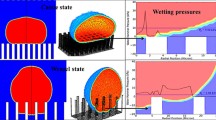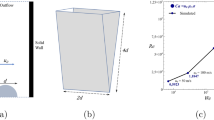Abstract
When high-velocity droplets make grazing impact with a superhydrophobic surface, the droplets undergo significant deformation before recoiling and rebounding from the surface. Two distinct operating regimes describe the response of the reflected droplet stream after impact. In the first regime, the droplets remain discrete and uniform after the impact, but exhibit rotation and significant oscillations. This regime dominates if each droplet can clear the impact region before the next droplet arrives. In the second regime, droplets cannot avoid coalescing into a puddle at the surface. A secondary jet is ejected from the puddle which breaks up into a random droplet stream after traveling a short distance due to the lack of a forced unstable perturbation. The droplet-to-droplet spacing in the incoming stream determines which regime rules, with the critical value correlated by a Weber number. In the first regime, a detailed accounting of the kinetic and potential energies reveals that neither droplet oscillation nor rotation can fully account for the loss of translational kinetic energy, indicating significant internal circulation must occur in the droplets at impact. An application of droplet rebound from a superhydrophobic surface is proposed.












Similar content being viewed by others
Notes
3,3,4,4,5,5,6,6,7,7,8,8,9,9,10,10,10-heptadecafluoro-1-decanethiol.
While it is non-zero for the shallow-angle impacts we have investigated, \( E_{K}^{*} = 0 \) for the case of large, perpendicularly impacting droplets (Clanet et al. 2004).
In our experiments, even if all of the initial kinetic energy of a droplet was instantaneously converted to heat, the droplet temperature would rise only ~0.01°.
References
Aussillous P, Quere D (2001) Liquid marbles. Nature 411:924–927
Aussillous P, Quere D (2004) Shape of rolling liquid drops. J Fluid Mech 512:133–151
Basaran O (1992) Nonlinear oscillations of viscous liquid drops. J Fluid Mech 241:169–198
Chandra S, Avedisian C (1991) On the collision of a droplet with a solid substrate. P R Soc London 432:13–41
Chen R, Wang H (2005) Effect of tangential speed on low-normal-speed liquid drop impact on a non-wettable solid surface. Exp Fluids 39:754–760
Chiarot P, Jones TB (2009) Dielectrophoretic deflection of ink jets. J Micromech Microeng 19:125018
Chiu S, Lin T (2005) Experiment on the dynamics of a compound drop impinging on a hot surface. Phys Fluids 17:122103
Choi C, Kim C (2006) Fabrication of a dense array of tall nanostructures over a large sample area with sidewall profile and tip sharpness control. Nanotechnology 17:5326–5333
Chwalek J, Jeanmaire D, Anagnostopoulos C (2000) Continuous ink jet printer with asymmetric heating drop deflection. US Patent #6,079,821
Clanet C, Beguin C, Richard D, Quere D (2004) Maximal deformation of an impacting drop. J Fluid Mech 517:199–208
Karl A, Frohn A (2000) Experimental investigation of interaction processes between droplets and hot walls. Phys Fluids 12:785–796
Lamb H (1945) Hydrodynamics, 6th edn. Dover Publications, New York
Larmour I, Bell S, Saunders G (2007) Remarkably simple fabrication of superhydrophobic surfaces using electroless galvanic deposition. Angew Chem Int Edit 46:1710–1712
Lau K, Bico J, Teo K, Chhowalla M, Amaratunga G, Milne W, McKinley G, Gleason K (2003) Superhydrophobic carbon nanotube forests. Nano Lett 3:1701–1705
Li X, Reinhoudt D, Crego-Calama M (2007) What do we need for a superhydrophobic surface? A review on the recent progress in the preparation of superhydrophobic surfaces. Chem Soc Rev 36:1350–1368
Mashayek F, Ashgriz N (1998) Nonlinear oscillations of drops with internal circulation. Phys Fluids 10:1071–1082
Mundo C, Sommerfeld M, Tropea C (1995) Droplet-wall collisions: experimental studies of the deformation and breakup process. Int J Multiphas Flow 21:151–173
Okumura K, Chevy F, Richard D, Quere D, Clanet C (2003) Water spring: a model for bouncing drops. Europhys Lett 62:237–243
Rayleigh L (1878) On the instability of jets. P Lond Math Soc 10:4–13
Rayleigh L (1879) On the capillary phenomena of jets. P R Soc London 29:71–97
Rayleigh JWS (1945) The theory of sound, vol. 2. Dover Publications, New York
Richard D, Quere D (2000) Bouncing water drops. Europhys Lett 50:769–775
Richard D, Clanet C, Quere D (2002) Contact time of a bouncing drop. Nature 417:811
Rioboo R, Marengo M, Tropea C (2002) Time evolution of liquid drop impact onto a solid, dry surface. Exp Fluids 33:112–124
Rioboo R, Voue M, Vaillant A, De Coninck J (2008) Drop impact on porous superhydrophobic polymer surfaces. Langmuir 24:14074–14077
Saffman P (1992) Vortex dynamics. Cambridge University Press, Cambridge
Sikalo S, Tropea C, Ganic E (2005) Impact of droplets onto inclined surfaces. J Colloid Interf Sci 286:661–669
Tsai P, Pacheco S, Pirat C, Lefferts L, Lohse D (2009) Drop impact upon micro- and nanostructured superhydrophobic surfaces. Langmuir 25:12293–12298
van Dam D, Le Clerc C (2004) Experimental study of the impact of an ink-jet printed droplet on a solid substrate. Phys Fluids 16:3403–3414
Acknowledgments
The authors acknowledge the financial and technical support of Eastman Kodak Co. We particularly thank J. Gao, Y. Xie, and G. Hawkins. The Center for Electronic Imaging Systems (CEIS) at the University of Rochester also contributed financially. A. Tucker-Schwartz of UCLA suggested use of the HDFT-based electroless process for creating superhydrophobic surfaces, and P. Osborne fabricated components for the experimental test fixture.
Author information
Authors and Affiliations
Corresponding author
Rights and permissions
About this article
Cite this article
Chiarot, P.R., Jones, T.B. Grazing impact of continuous droplet streams with a superhydrophobic surface. Exp Fluids 49, 1109–1119 (2010). https://doi.org/10.1007/s00348-010-0860-x
Received:
Revised:
Accepted:
Published:
Issue Date:
DOI: https://doi.org/10.1007/s00348-010-0860-x




